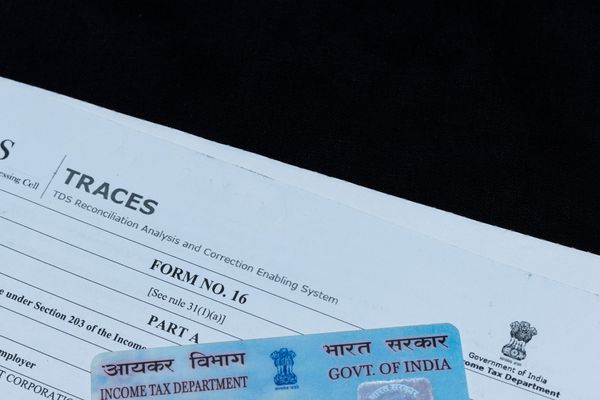How to Check Your TDS Status by Using Your PAN Card?

Tax Deducted at Source, or TDS under the Income Tax act of 1961, is a system of collecting taxes in India at the time when the income is generated, rather than at a later date. In this system, a person or entity responsible for making payments, such as an employer or a bank, deducts a certain percentage of tax from the income of the recipient and remits it to the government on behalf of the recipient.
This blog gives an overview of how to check TDS status through a PAN card online. Read to know more!
What is TDS Return?
TDS return is a statement filed by the person or entity who has deducted tax at source, on behalf of the recipient of income. It is a summary of all the transactions made during a particular quarter or financial year for which TDS has been deducted.
Every person or entity who is required to deduct TDS is required to file a TDS return with the Income Tax Department on a quarterly basis. The TDS return contains details of the tax deducted, the name and PAN of the deductee, the nature of the payment, and the amount of the payment.
The due date for filing TDS returns is 31st July for the first quarter, 31st October for the second quarter, 31st January for the third quarter, and 31st May for the fourth quarter of the financial year. Failure to file TDS returns on time can attract penalties and interest.
Filing of TDS returns is mandatory for all persons or entities who have deducted tax at source, even if no tax has been deducted during the quarter. It is an important compliance requirement under the Indian Income Tax Act, of 1961.
Additionally, the deductor has to fill out the following forms depending on the type of TDS deduction:
- Form 24Q for TDS on salary
- Form 26QB for TDS on sale of property
- Form 26QC for TDS on rent
- Form 26Q TDS on all payments (except salary)
- Form 27Q in case of TDS for Non-Resident Indians (except salary)
Also Read
How to Check TDS Status by PAN Card?
In order to check TDS status go to TDS CPC (TDS Central Processing Cell) it is an online portal of the Income Tax Department providing various online TDS facilities. Also called the TRACES (TDS Reconciliation Analysis and Correction Enabling System), it allows both deductors and payers to view their TDS paid, and reconcile them when filing ITR (income tax return) or seeking refunds.
To check TDS status by Pan Card follow these simple steps:
- Visit the TRACES portal
- Enter the verification code as shown and click on ‘Proceed’. You can click on ‘Refresh Image’ if you have trouble viewing the code.
- To know your quarterly TDS/TCS statement, enter the deductee’s PAN and deductor’s TAN.
- Select the financial year, quarter, and type of return (salary/non-salary) from respective drop-down menus.
- Click on ‘Go’ to view details of TDS deduction on the screen. This includes details about your total income, tax deducted, and deposited to the government.
How to Check TDS Status through Income Tax Portal?
Individuals who already have an account on the Income Tax e-filing website can check their TDS status by following the steps below:
Step 1: Login to Income Tax e-filing by entering your personal credentials like username and password.
Step 2: Select the “View Form 26AS” option in “My Account.”
Step 3: Select this form option after which you will be redirected to the TRACES portal
Step 4: Individuals must then select the appropriate fiscal or assessment year and format for viewing the file.
Step 5: Individuals can view their TDS status on the following page and print or download it for future reference. Individuals must, however, provide their respective PAN numbers when downloading a file in order to access the password-protected file.
What are the Important Details Available in the TDS Statements?
Here are some important TDS statements that each individual needs to be aware of:
- A tax deducted on a taxpayer’s behalf
- A tax collected on a taxpayer’s behalf.
- Refunds received during a fiscal or assessment year
- Transaction details of bonds, shares, or mutual funds
- Deduction at the time of sale of immovable property
- Deposited self-assessment tax or advance tax by an assessee with a valid PAN number
- Information about TDS defaults and statement processing.
Final Word
TDS status can be checked online using your PAN Card in three ways: TDSCPC, Income Tax e-filing website, and net banking. You will need to provide the PAN of whoever deducted TDS from payments as well as the TAN of the deductor for all of these.
Want to save on taxes? Invest in Navi Mutual Fund’s ELSS Tax Saver Nifty 50 Index Fund to receive tax benefits of up to 1.5 lakh. Download the Navi app and start investing today!
FAQs
Employers issue Form 16 as a certificate for payment of TDS on salary. Banks and other financial institutions issue Form 16A for deduction from fixed deposits. Form 16C is the TDS certificate for rent payments, while Form 16B is for TDS on sale of properties.
If you deduct TDS in the month of July, you must deposit this amount by August 7 of the same year. For TDS deductions in March, you can deposit the same by April 30. The due date is 30 days from the date of TDS deduction for TDS on rent payments and purchase of properties.
Under Section 234E of the Income Tax Act, you have to pay a penalty of Rs. 200 per day for late filing of TDS. You have to pay this amount for every day of delay till you deposit the TDS or until the amount is equal to the TDS amount.
The liability of deducting TDS is on the person making payments subject to tax deductions. Such persons have to deduct TDS from the payment as per the Income Tax Act. For example, an employer has to deduct TDS before paying monthly salaries to employees.
Yes, under Section 201(A), you have to pay interest on the TDS amount for late deposits after deduction. You have to pay interest at a rate of 1.5% per month from the date of deduction to the day on which you actually deposit it.
Read More on Income Tax Act

What is Form 26QB for TDS? How to Download and Submit it?
While purchasing a property, buyers are liable to pay various taxes. The Finance Act, 2013 made TDS... Read More »PF Withdrawal Rules 2023 – Rules, Documents Required and Types
EPF/PF Withdrawal Employees’ Provident Fund (abbreviated as EPF) is a popular retirement sav... Read More »Stamp Duty and Property Registration Charges in Delhi 2023
It is compulsory for property buyers in the Capital to pay stamp duty in Delhi during property regi... Read More »Income Tax Return – Documents, Forms and How to File ITR Online AY 2023-24
In India, it is mandatory for all taxpayers who earn more than the basic tax exemption limit to fil... Read More »What is Section 80CCD – Deductions for National Pension Scheme and Atal Pension Yojana
The Income Tax Act provides a number of deductions and tax benefits to taxpayers, so they can strat... Read More »Tax on Dividend Income: Sources, Tax Rate and TDS on dividend income
What are Dividends? Companies may raise funds for running their operations by selling equity. Th... Read More »Section 112A of Income Tax Act: Taxation on Long-Term Capital Gains
What is Section 112A? Section 112A of the Income Tax Act was announced in Budget 2018 to replace... Read More »Section 206AB of Income Tax Act: Eligibility And TDS Rate
Section 206AB was introduced in the Finance Bill 2021 as a new provision pertaining to higher deduc... Read More »What is a Credit Note in GST – Example, Format and Steps
A GST Credit Note is mandatory for any GST-registered supplier of goods or services. As a supplier,... Read More »Exemptions and Deductions Under Section 10 of Income Tax Act
What Is Section 10 of the Income Tax Act? Section 10 of the Income Tax Act, 1961 provides tax-sa... Read More »Section 57 of the Income-tax Act – Income from Other Sources
It is quite likely that many entities - individuals as well as businesses - have multiple sources o... Read More »What is Dearness Allowance? – Types, Calculation, and Current Rate
What is Dearness Allowance? Dearness Allowance Meaning - Dearness Allowance (DA) is an allowance... Read More »Top 10 Chit Fund Schemes in India in 2023
Chit funds are one of the most popular return-generating saving schemes in India. It is a financial... Read More »10 Best Gold ETFs in India to Invest in April 2023
Gold ETFs or Gold Exchange Traded Funds are passively managed funds that track the price of physica... Read More »10 Best Demat Accounts in India for Beginners in 2023
Creation of Demat accounts revolutionised the way trades were conducted at the stock exchanges. It... Read More »20 Best Index Funds to Invest in India in April 2023
What is an Index Fund? An index fund is a type of mutual fund or exchange-traded fund (ETF) that... Read More »Best Arbitrage Mutual Funds to Invest in India in April 2023
Arbitrage funds are hybrid mutual fund schemes that aim to make low-risk profits by buying and sell... Read More »10 Best SIP Plans in India to Invest in April 2023
What is SIP? SIP or Systematic Investment Plan is a method of investing a fixed amount in ... Read More »10 Best Corporate Bond Funds in India to Invest in April 2023
Corporate bond funds are debt funds that invest at least 80% of the investment corpus in companies ... Read More »10 Best Bank for Savings Account in India [Highest Interest Rate 2023]
Savings account is a type of financial instrument offered by several banks. It lets you safely depo... Read More »






















